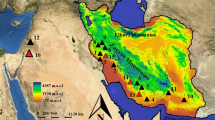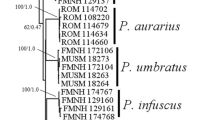Abstract
Background
The lack of morphological differentiation among chiropteran species and cryptic speciation impedes species identification. DNA-based approaches help species identification and contribute to the discovery of additional species. Rhyneptesicus nasutus (Sind Serotine Bat) is a rare and poorly studied species in Pakistan.
Methods
This study explores the range extension of Sind Bat within the territorial limits of Pakistan from Sind and Baluchistan to Federally Administered Areas of Pakistan. No molecular record exists for the species in Pakistan. In the present study, we for the first time confirm species identification of Rhyneptesicus nasutus from Pakistan using a genetic marker (cytochrome b) along with morphometric analysis. A neighbor-joining tree based on Kimura-2 parameters was created to infer phylogenetic relationships. We sequenced the cytochrome b gene segment and conducted a phylogenetic analysis with previously published data from other countries.
Results
Sequences from Pakistan formed a clade with Iranian Rhyneptesicus nasutus specimens suggesting a common ancestry. Various morphometric parameters (mean values) were measured, including Head and Body length (44.3 mm), Tail length (43.4 mm), Hindfoot length (8.3 mm), Forearm length (35.7 mm), and Ear length 36 mm while 5th Metacarpal Length, 4th Metacarpal Length, and 3rd Metacarpal Lengths were 33.2 mm, 34.7 mm, and 35.3 mm. Approaches based on DNA barcoding reveal a high diversity of bat species in the study area.
Conclusion
The data will enable researchers to build an improved evolutionary framework of the Serotine Bats from this region and subsequently reconstruct a detailed evolutionary history of the genus. Further research is required to test other molecular markers to support the findings of the current study in Pakistan.



Similar content being viewed by others
References
Mora C, Tittensor DP, Adl S, Simpson AGB, Worm B (2011) How many species are there on Earth and in the ocean? PLoS Biol 9:e1001127
Burgin CJ et al (2018) How many species of mammals are there? J Mammal 99(1):1–14
Boyles JG et al (2011) Economic importance of bats in agriculture. Science 332(6025):41–42
García-Herrera LV, Ramírez-Fráncel LA, Guevara G, Reinoso-Flórez G, Sánchez-Hernández A, Lim BK, Losada-Prado S (2021) Foraging strategies, craniodental traits, and interaction in the bite force of Neotropical frugivorous bats (Phyllostomidae: Stenodermatinae). Ecol Evol 11:13756–13772
Bickford D et al (2007) Cryptic species as a window on diversity and conservation. Trends Ecol Evol 22(3):148–155
Wilson DE, Reeder DM (2005) Mammal species of the world: a taxonomic and geographic reference. JHU Press, Baltimore
Theodoridis S, Fordham DA, Brown SC, Li S, Rahbek C, Nogues-Bravo D (2020) Evolutionary history and past climate change shape the distribution of genetic diversity in terrestrial mammals. Nat Commun 11(1):1–11
Clare EL (2011) Cryptic species? Patterns of maternal and paternal gene flow in eight Neotropical bats. PLoS ONE 6(7):e21460
Juste J, Benda P, Garcia‐Mudarra JL, Ibanez C (2013) Phylogeny and systematics of Old World serotine bats (genus Eptesicus, Vespertilionidae, Chiroptera): an integrative approach. Zoolog Scr 42(5):441–457
Bates P, Harrison D (1998) Bats of the Indian subcontinent. Biodivers Conserv 7(10):1383–1386
IUCN (2021) The IUCN red list of threatened species. Version 2021-2. Available at https://www.iucnredlist.org
Francis CM et al (2010) The role of DNA barcodes in understanding and conservation of mammal diversity in Southeast Asia. PLoS ONE 5(9):e12575
Linacre A, Lee JCI (2016) Species determination: the role and use of the cytochrome b gene. Forensic DNA typing protocols. Humana Press, New York, pp 287–296
Vindigni G, Pulvirenti A, Alaimo S, Monaco C, Spina D, Peri I (2021) Bioinformatics approach to mitigate mislabeling in EU Seafood market and protect consumer health. Int J Environ Res Public Health 18(14):7497
Roberts TJ (1977) The mammals of Pakistan. E. Benn, London
Wang TY, Wang L, Zhang JH, Dong WH (2011) A simplified universal genomic DNA extraction protocol suitable for PCR. Genet Mol Res 10(1):519–525
Kocher TD et al (1989) Dynamics of mitochondrial DNA evolution in animals: amplification and sequencing with conserved primers. Proc Natl Acad Sci 86(16):6196–6200
Sanger F, Nicklen S, Coulson AR (1977) DNA sequencing with chain-terminating inhibitors. Proc Natl Acad Sci 74(12):5463–5467
Pty T Ltd (2018) Chromas lite software
Kumar S et al (2018) MEGA X: molecular evolutionary genetics analysis across computing platforms. Mol Biol Evol 35(6):1547–1549
Harrison D, Bates P (1991) The mammals ofArabia. Harrison Zoological Museum, Kent
Hoofer SR, Van Den Bussche RA, Horáček I (2006) Generic status of the American pipistrelles (Vespertilionidae) with description of a new genus. J Mammal 87(5):981–992
Blanford WT (1898) The Fauna of British India: including Ceylon and Burma, vol 4. Taylor & Francis, Abingdon-on-Thames
Comelis MT, Bueno LM, Góes RM, Taboga SR, Morielle-Versute E (2018) Morphological and histological characters of penile organization in eleven species of molossid bats. Zoology 127:70–83
Zeale MR, Bennitt E, Newson SE, Packman C, Browne WJ, Harris S, Stone E (2016) Mitigating the impact of bats in historic churches: the response of Natterer’s bats Myotis nattereri to artificial roosts and deterrence. PLoS ONE 11(1):e0146782
Srinivasulu C et al (2019) Integrated approaches to identifying cryptic bat species in areas of high endemism: the case of Rhinolophus andamanensis in the Andaman Islands. PLoS ONE 14(10):e0213562
Benda P et al (2010) Noteworthy records of bats from Yemen with description of a new species from Socotra. Hystrix Italian J Mammal 22(1):23–56
Dool SE, Puechmaille SJ, Foley NM, Allegrini B, Bastian A, Mutumi GL, Jacobs DS (2016) Nuclear introns outperform mitochondrial DNA in inter-specific phylogenetic reconstruction: lessons from horseshoe bats (Rhinolophidae: Chiroptera). Mol Phylogenet Evol 97:196–212
Bates PJ (1997) Bats of the Indian Subcontinent: Harrison Zoological Museum publication. Sevenoaks, Kent, United Kingdom
Roberts T (1997) The mammals of Pakistan (revised ed). Oxford University Press, Karachi
Funding
No funding was received from anybody. All the expenditures for research work were supported by the authors.
Author information
Authors and Affiliations
Corresponding author
Ethics declarations
Conflict of interest
The authors declare no conflict of interest with anyone.
Ethical approval
The author(s) declares that the animals used in this research work were handled with ethical standards for animal care and use in research approved by Society for Prevention of Cruelty to Animals (SPCA, University of Veterinary and Animal Sciences, Lahore, Pakistan.
Additional information
Publisher's Note
Springer Nature remains neutral with regard to jurisdictional claims in published maps and institutional affiliations.
Rights and permissions
About this article
Cite this article
Idnan, M., Mansoor, S., Khawar, M.B. et al. Range extension and species confirmation of Rhyneptesicus nasutus (Sind Serotine Bat) (Mammalia:Chiroptera) from Bajaur Agency, FATA, Pakistan. Mol Biol Rep 49, 1791–1797 (2022). https://doi.org/10.1007/s11033-021-06989-4
Received:
Accepted:
Published:
Issue Date:
DOI: https://doi.org/10.1007/s11033-021-06989-4




